Special Senses Anatomy of the Visual System Review Sheet
People are responsive creatures; hold freshly baked bread before us, and our mouths water; a sudden clap of thunder makes u.s.a. jump; these "irritants" and many others are the stimuli that continually greet u.s.a. and are interpreted by our nervous organisation; the 4 "traditional" senses—olfactory property, taste, sight, and hearing- are called special senses.
Functions of Special Senses
The functions of the 5 special senses include:
- Vision. Sight or vision is the adequacy of the middle(s) to focus and detect images of visible calorie-free on photoreceptors in the retina of each eye that generates electrical nervus impulses for varying colors, hues, and effulgence.
- Hearing. Hearing or audition is the sense of sound perception.
- Taste. Taste refers to the adequacy to detect the taste of substances such as food, certain minerals, and poisons, etc.
- Odor. Smell or olfaction is the other "chemical" sense; odor molecules possess a variety of features and, thus, excite specific receptors more or less strongly; this combination of excitatory signals from different receptors makes upwards what we perceive as the molecule's smell.
- Touch. Touch or somatosensory, also called tactition or mechanoreception, is a perception resulting from activation of neural receptors, generally in the peel including hair follicles, just likewise in the tongue, throat, and mucosa.
The Eye and Vision
Vision is the sense that has been studied most; of all the sensory receptors in the body seventy% are in the optics.
Beefcake of the Eye
Vision is the sense that requires the virtually "learning", and the eye appears to delight in being fooled; the old expression "Y'all meet what yous await to encounter" is oftentimes very truthful.
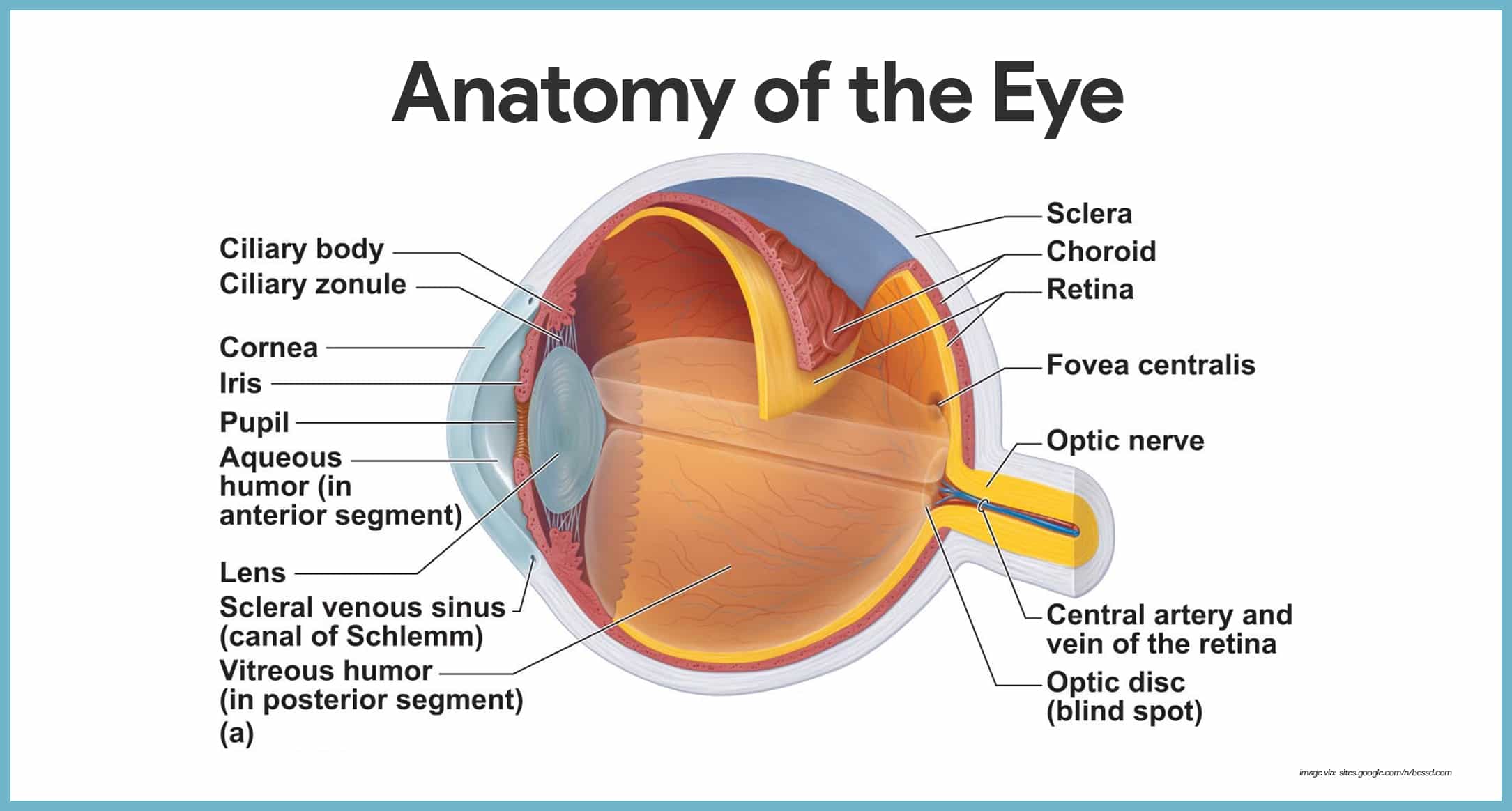
External and Accessory Structures
The accessory structures of the eye include the extrinsic eye muscles, eyelids, conjunctiva, and lacrimal apparatus.
- Eyelids. Anteriorly, the eyes are protected by the eyelids, which see at the medial and lateral corners of the eye, the medial and lateral commissure (canthus), respectively.
- Eyelashes. Projecting from the border of each eyelid are the eyelashes.
- Tarsal glands. Modified sebaceous glands associated with the eyelid edges are the tarsal glands; these glands produce an oily secretion that lubricates the eye; ciliary glands, modified sweat glands, prevarication between the eyelashes.
- Conjunctiva. A frail membrane, the conjunctiva, lines the eyelids and covers role of the outer surface of the eyeball; information technology ends at the edge of the cornea by fusing with the corneal epithelium.
- Lacrimal apparatus. The lacrimal apparatus consists of the lacrimal gland and a number of ducts that drain the lacrimal secretions into the nasal cavity.
- Lacrimal glands. The lacrimal glands are located higher up the lateral end of each centre; they continually release a common salt solution (tears) onto the anterior surface of the eyeball through several small ducts.
- Lacrimal canaliculi. The tears affluent beyond the eyeball into the lacrimal canaliculi medially, then into the lacrimal sac, and finally into the nasolacrimal duct, which empties into the nasal cavity.
- Lysozyme. Lacrimal secretion also contains antibodies and lysozyme, an enzyme that destroys bacteria; thus, it cleanses and protects the center surface as it moistens and lubricates information technology.
- Extrinsic middle muscle. Six extrinsic, or external, eye muscles are attached to the outer surface of the eye; these muscles produce gross eye movements and make it possible for the eyes to follow a moving object; these are the lateral rectus, gedial rectus, superior rectus, inferior rectus, junior oblique, and superior oblique.
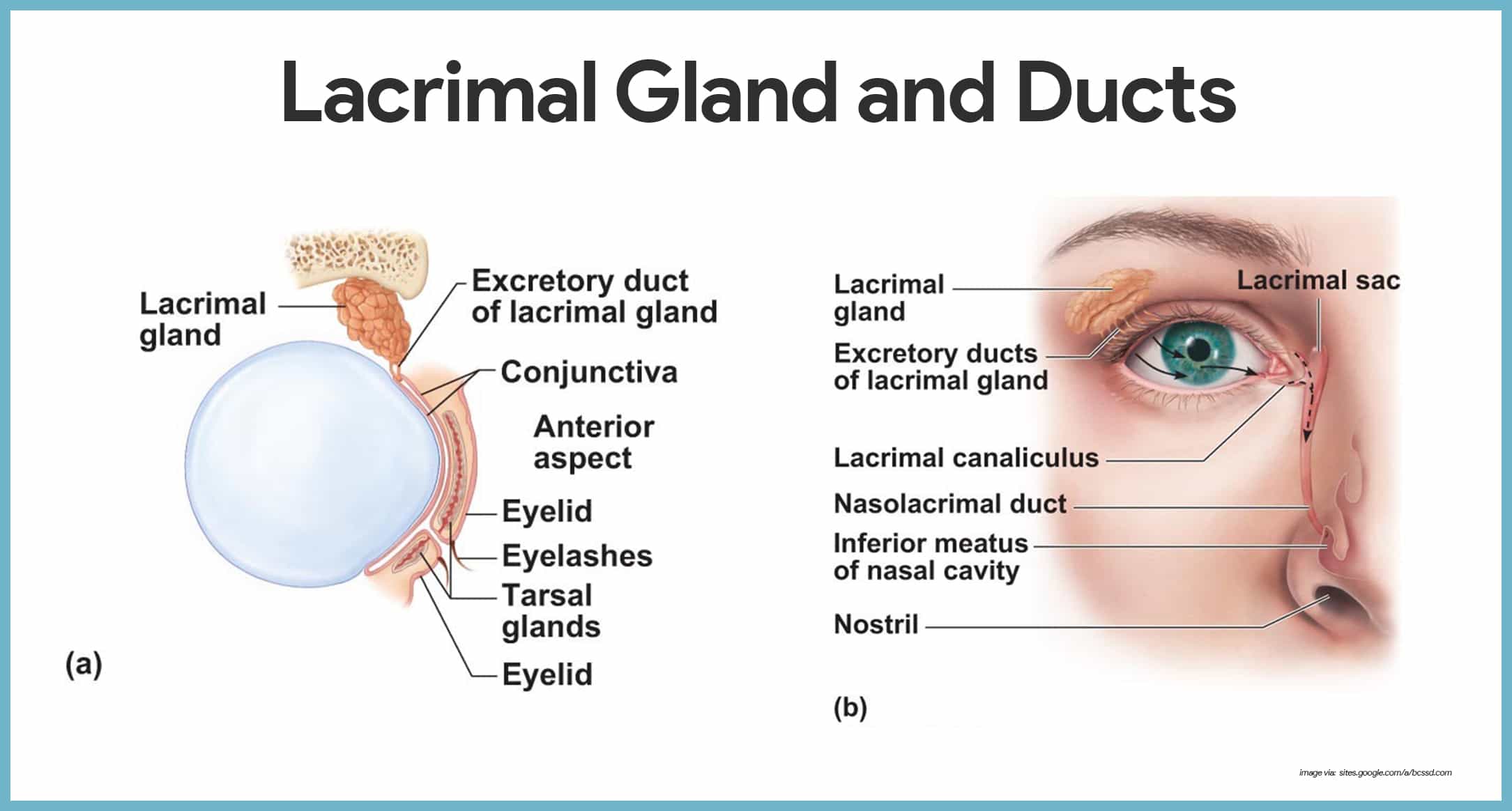
Internal Structures: The Eyeball
The eye itself, unremarkably called the eyeball, is a hollow sphere; its wall is composed of iii layers, and its interior is filled with fluids called humors that help to maintain its shape.
Layers Forming the Wall of the Eyeball
Now that nosotros take covered the general anatomy of the eyeball, we are ready to go specific.
- Fibrous layer. The outermost layer, called the fibrous layer, consists of the protective sclera and the transparent cornea.
- Sclera. The sclera, thick, glistening, white connective tissue, is seen anteriorly equally the "white of the center".
- Cornea. The central anterior portion of the fibrous layer is crystal clear; this "window" is the cornea through which low-cal enters the eye.
- Vascular layer. The eye eyeball of the layer, the vascular layer, has three distinguishable regions: the choroid, the ciliary trunk, and the iris.
- Choroid. Most posterior is the choroid, a blood-rich nutritive tunic that contains a nighttime pigment; the pigment prevents light from scattering inside the eye.
- Ciliary body. Moving anteriorly, the choroid is modified to form two smoothen muscle structures, the ciliary body, to which the lens is fastened by a suspensory ligament called ciliary zonule, and so the iris.
- Pupil. The pigmented iris has a rounded opening, the pupil, through which light passes.
- Sensory layer. The innermost sensory layer of the eye is the delicate two-layered retina, which extends anteriorly only to the ciliary body.
- Pigmented layer. The outer pigmented layer of the retina is composed pigmented cells that, like those of the choroid, absorb low-cal and prevent light from scattering within the centre.
- Neural layer. The transparent inner neural layer of the retina contains millions of receptor cells, the rods and cones, which are called photoreceptors because they respond to light.
- Two-neuron concatenation. Electrical signals pass from the photoreceptors via a two-neuron chain-bipolar cells and so ganglion cells– before leaving the retina via optic nervus as nervus impulses that are transmitted to the optic cortex; the result is vision.
- Optic disc. The photoreceptor cells are distributed over the entire retina, except where the optic nerve leaves the eyeball; this site is called the optic disc, or blind spot.
- Fovea centralis. Lateral to each bullheaded spot is the fovea centralis, a tiny pit that contains only cones.
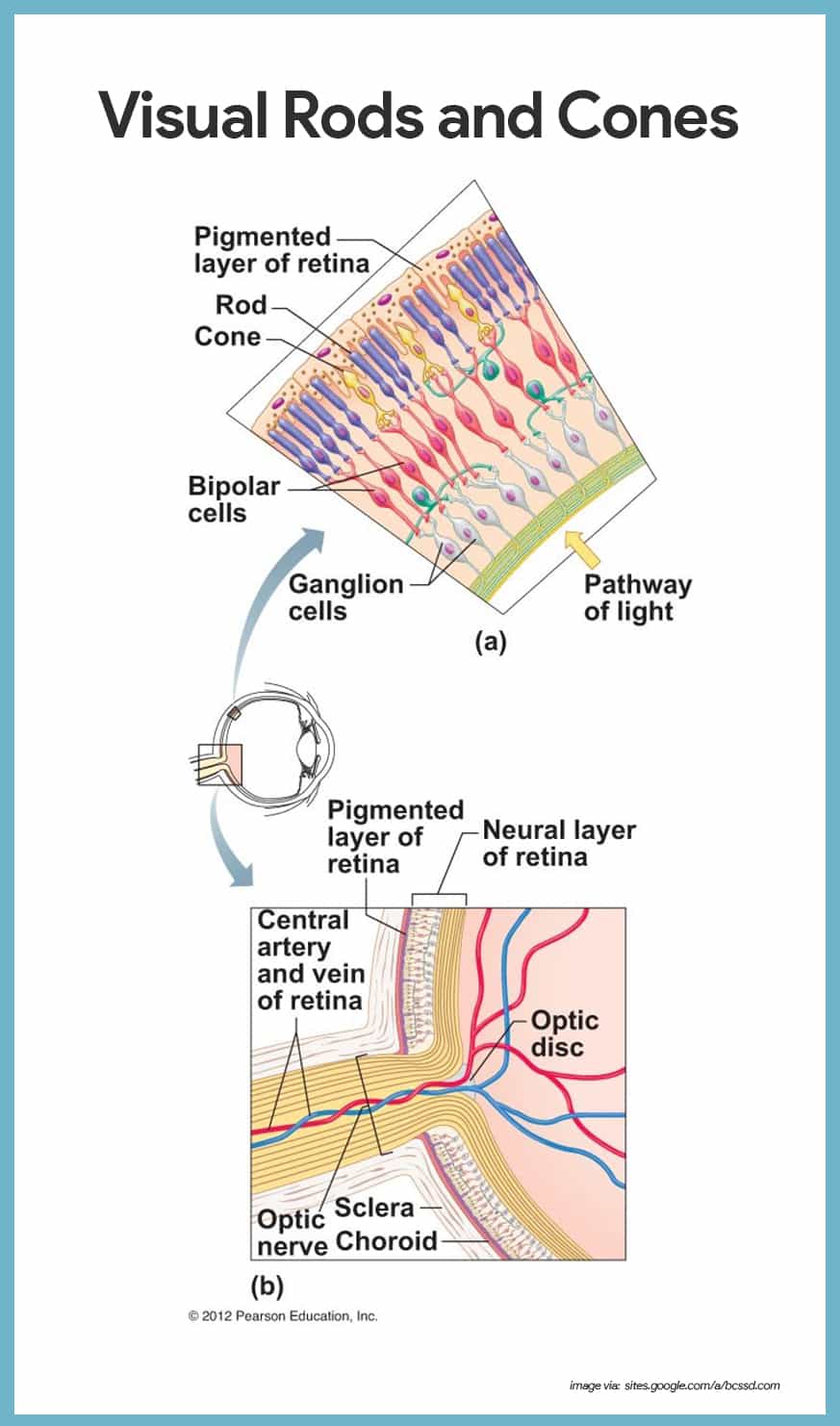
Lens
Lite inbound the centre is focused on the retina by the lens, a flexible biconvex, crystal-like structure.
- Chambers. The lens divides the centre into 2 segments or chambers; the anterior (aqueous) segment, anterior to the lens, contains a clear, watery fluid called aqueous humor; the posterior (vitreous) segment posterior to the lens, is filled with a gel-similar substance called either vitreous humor, or the vitreous body.
- Vitreous sense of humour. Vitreous humor helps forbid the eyeball from collapsing in by reinforcing it internally.
- Aqueous humor. Aqueous humour is like to blood plasma and is continually secreted by a special of the choroid; information technology helps maintain intraocular force per unit area, or the pressure inside the eye.
- Canal of Schlemm. Aqueous humor is reabsorbed into the venous blood through the scleral venous sinus, or canal of Schlemm, which is located at the junction of the sclera and cornea.
Eye Reflexes
Both the external and internal eye muscles are necessary for proper eye function.
- Photopupillary reflex. When the eyes are of a sudden exposed to vivid light, the pupils immediately constrict; this is the photopupillary reflex; this protective reflex prevents excessively bright light from damaging the delicate photoreceptors.
- Accommodation pupillary reflex. The pupils also tuck reflexively when nosotros view close objects; this adaptation pupillary reflex provides for more than astute vision.
The Ear: Hearing and Balance
At starting time glance, the machinery for hearing and balance appears very rough.
Anatomy of the Ear
Anatomically, the ear is divided into three major areas: the external, or outer, ear; the middle ear, and the internal, or inner, ear.
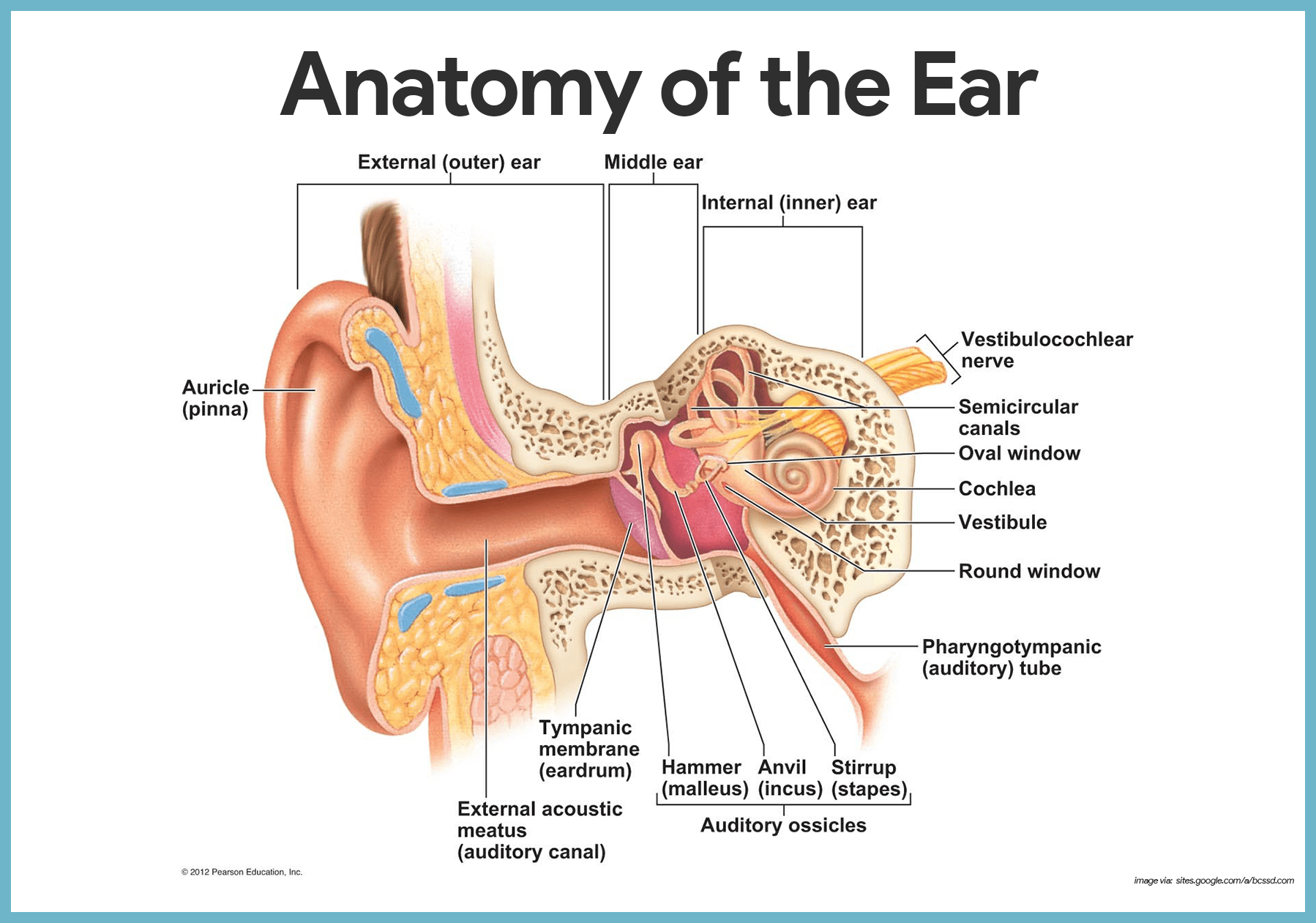
External (Outer) Ear
The external, or outer, ear is composed of the auricle and the external acoustic meatus.
- Auricle. The auricle, or pinna, is what most people call the "ear"- the shell-shaped structure surrounding the auditory canal opening.
- External acoustic meatus. The external acoustic meatus is a brusque, narrow chamber carved into the temporal bone of the skull; in its skin-lined walls are the ceruminous glands, which secrete waxy, yellow cerumen or earwax, which provides a pasty trap for foreign bodies and repels insects.
- Tympanic membrane. Audio waves entering the auditory canal somewhen hit the tympanic membrane, or eardrum, and crusade it to vibrate; the canal ends at the ear drum, which separates the external from the center ear.
Middle Ear
The middle ear, or tympanic cavity, is a small, air-filled, mucosa-lined cavity within the temporal bone.
- Openings. The tympanic cavity is flanked laterally by the eardrum and medially by a bony wall with two openings, the oval window and the inferior, membrane-covered round window.
- Pharyngotympanic tube. The pharyngotympanic tube runs obliquely downwards to link the middle ear crenel with the throat, and the mucosae lining the two regions are continuous.
- Ossicles. The tympanic cavity is spanned by the three smallest basic in the body, the ossicles, which transmit the vibratory motion of the eardrum to the fluids of the inner ear; these bones, named for their shape, are the hammer, or malleus, the anvil, or incus, and the stirrup, or stapes.
Internal (Inner) Ear
The internal ear is a maze of bony chambers, called the bony, or osseous, labyrinth, located deep within the temporal os behind the center socket.
- Subdivisions. The three subdivisions of the bony labyrinth are the spiraling, pea-sized cochlea, the foyer, and the semicircular canals.
- Perilymph. The bony labyrinth is filled with a plasma-like fluid called perilymph.
- Membranous labyrinth. Suspended in the perilymph is a membranous labyrinth, a system of membrane sacs that more or less follows the shape of the bony labyrinth.
- Endolymph. The membranous labyrinth itself contains a thicker fluid called endolymph.
Chemic Senses: Taste and Smell
The receptors for taste and olfaction are classified as chemoreceptors because they respond to chemicals in solution.
Olfactory Receptors and the Sense of Smell
Even though our sense of smell is far less acute than that of many other animals, the human nose is still no slouch in picking upward small differences in odors.

- Olfactory receptors. The thousands of olfactory receptors, receptors for the sense of olfactory property, occupy a stamp stamp-sized area in the roof of each nasal cavity.
- Olfactory receptor cells. The olfactory receptor cells are neurons equipped with olfactory hairs, long cilia that protrude from the nasal epithelium and are continuously bathed past a layer of mucus secreted by underlying glands.
- Olfactory filaments. When the olfactory receptors located on the cilia are stimulated past chemicals dissolved in the mucus, they transmit impulses along the olfactory filaments, which are bundled axons of olfactory neurons that collectively brand up the olfactory nervus.
- Olfactory nervus. The olfactory nerve conducts the impulses to the olfactory cortex of the brain.
Gustation Buds and the Sense of Gustation
The word taste comes from the Latin word taxare, which means "to touch on, guess, or approximate".
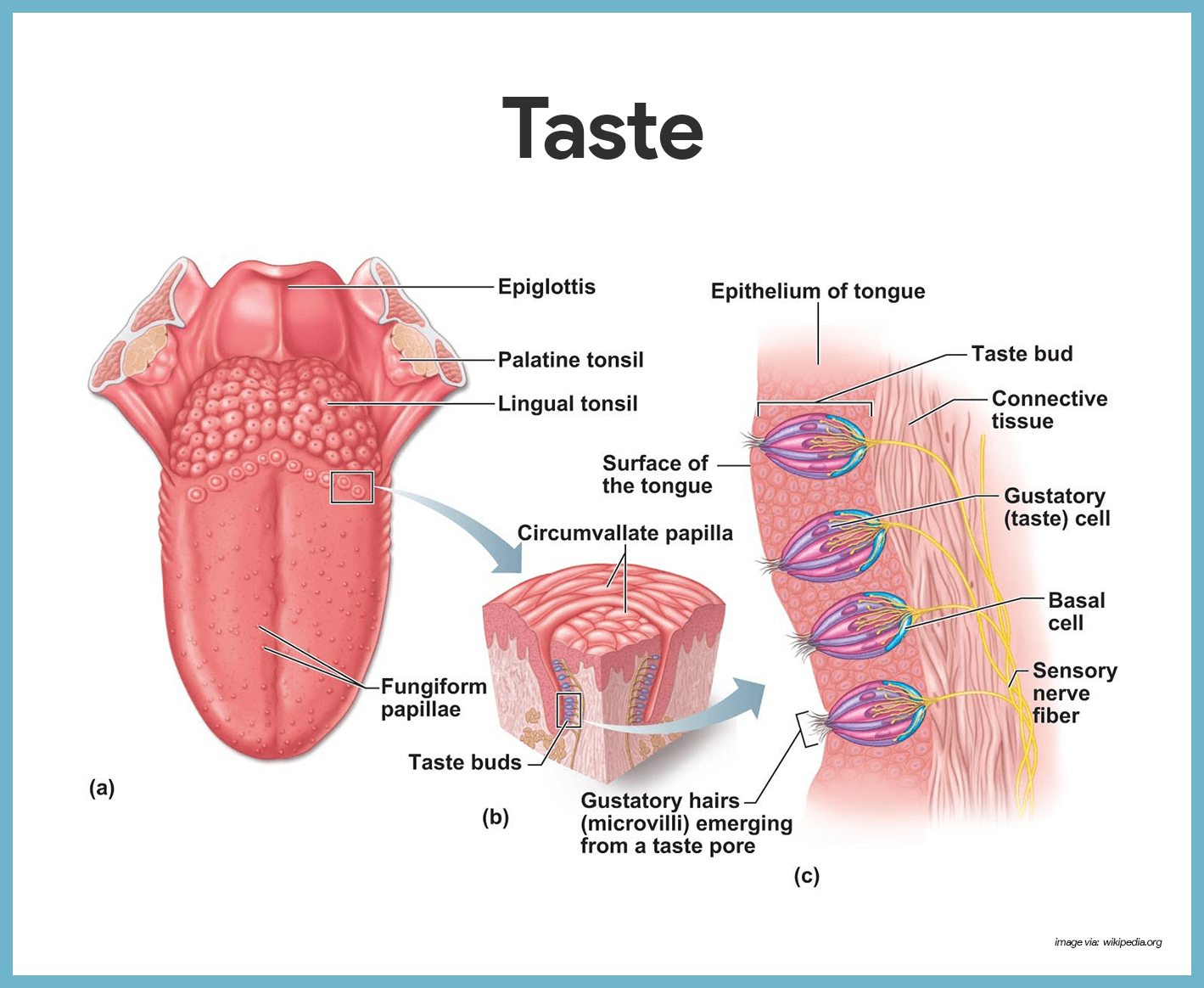
- Taste buds. The taste buds, or specific receptors for the gustation, are widely scattered in the oral cavity; of the x, 000 or and so taste buds we have, almost are on the natural language.
- Papillae. The dorsal natural language surface is covered with modest peg-similar projections, or papillae.
- Circumvallate and fungiform papillae. The taste buds are found on the sides of the large circular circumvallate papillae and on the tops of the more numerous fungiform papillae.
- Gustatory cells. The specific cells that respond to chemicals dissolved in the saliva are epithelial cells called gustatory cells.
- Gustatory hairs. Their long microvilli- the gustatory hairs- protrude through the gustatory modality pore, and when they are stimulated, they depolarize and impulses are transmitted to the brain.
- Facial nerve. The facial nervus (VII) serves the inductive function of the tongue.
- Glossopharyngeal and vagus nerves. The other two cranial nerves- the glossopharyngeal and vagus- serve the other taste bud-containing areas.
- Basal cells. Taste bud cells are among the near dynamic cells in the body, and they are replaced every seven to 10 days by basal cells institute in the deeper regions of the taste buds.
Physiology of the Special Senses
The processes that makes our special senses piece of work include the following:
Pathway of Light through the Eye and Lite Refraction
When calorie-free passes from one substance to another substance that has a unlike density, its speed changes and its rays are bent, or refracted.
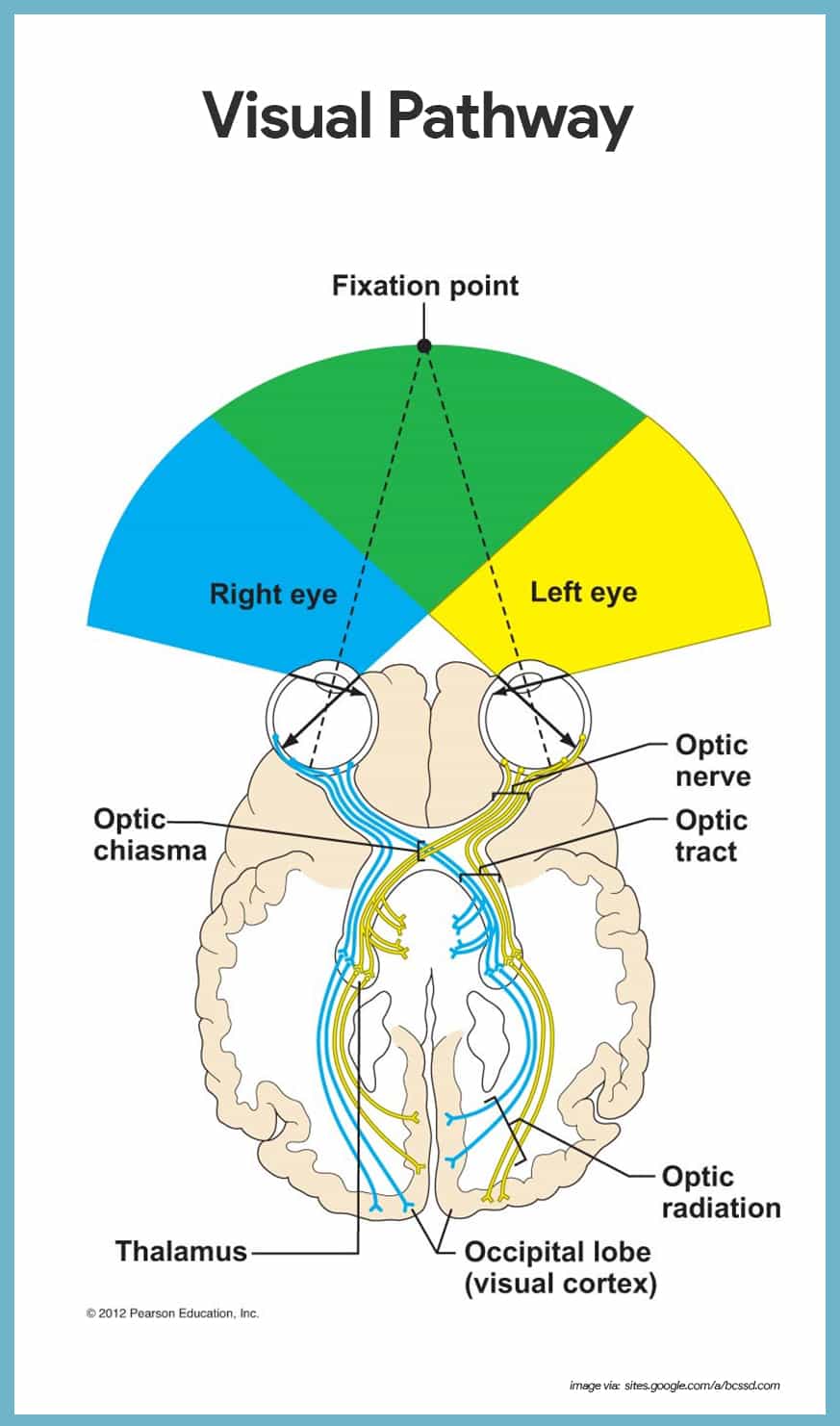
- Refraction. The refractive, or angle, ability of the cornea and humors is constant; however, that of the lens tin be inverse by irresolute its shape- that is, by making information technology more or less convex, then that light tin be properly focused on the retina.
- Lens. The greater the lens convexity, or burl, the more information technology bends the low-cal; the flatter the lens, the less it bends the light.
- Resting eye. The resting centre is "set" for afar vision; in general, light from a distance source approaches the eye as parallel rays and the lens does not demand to modify shape to focus properly on the retina.
- Calorie-free deviation. Light from a close object tends to scatter and to diverge, or spread out, and the lens must bulge more than to make close vision possible; to achieve this, the ciliary body contracts allowing the lens to become more convex.
- Accommodation. The ability of the eye to focus specifically for shut objects (those less than 20 feet away) is chosen adaptation.
- Real image. The image formed on the retina as a upshot of the light-bending activity of the lens is a real image- that is, it is reversed from left to right, upside down, and smaller than the object.
Visual Fields and Visual Pathways to the Brain
Axons carrying impulses from the retina are bundled together at the posterior aspect of the eyeball and issue from the back of the eye as the optic nerve.
- Optic chiasma. At the optic chiasma, the fibers from the medial side of each eye cantankerous over to the opposite side of the brain.
- Optic tracts. The cobweb tracts that result are the optic tracts; each optic tract contains fibers from the lateral side of the eye on the same side and the medial side of the opposite middle.
- Optic radiation. The optic tract fibers synapse with neurons in the thalamus, whose axons form the optic radiations, which runs to the occipital lobe of the brain; there they synapse with the cortical cells, and visual interpretation, or seeing, occurs.
- Visual input. Each side of the brain receives visual input from both eyes-from the lateral field of vision of the eye on its own side and from the medial field of the other eye.
- Visual fields. Each center "sees" a slightly dissimilar view, simply their visual fields overlap quite a scrap; as a issue of these two facts, humans have binocular vision, literally "2-eyed vision" provides for depth perception, also called "3-dimensional vision" equally our visual cortex fuses the two slightly different images delivered past the two eyes.
Mechanisms of Equilibrium
The equilibrium receptors of the inner ear, collectively called the vestibular apparatus, can be divided into two functional arms- one arm responsible for monitoring static equilibrium and the other involved with dynamic equilibrium.
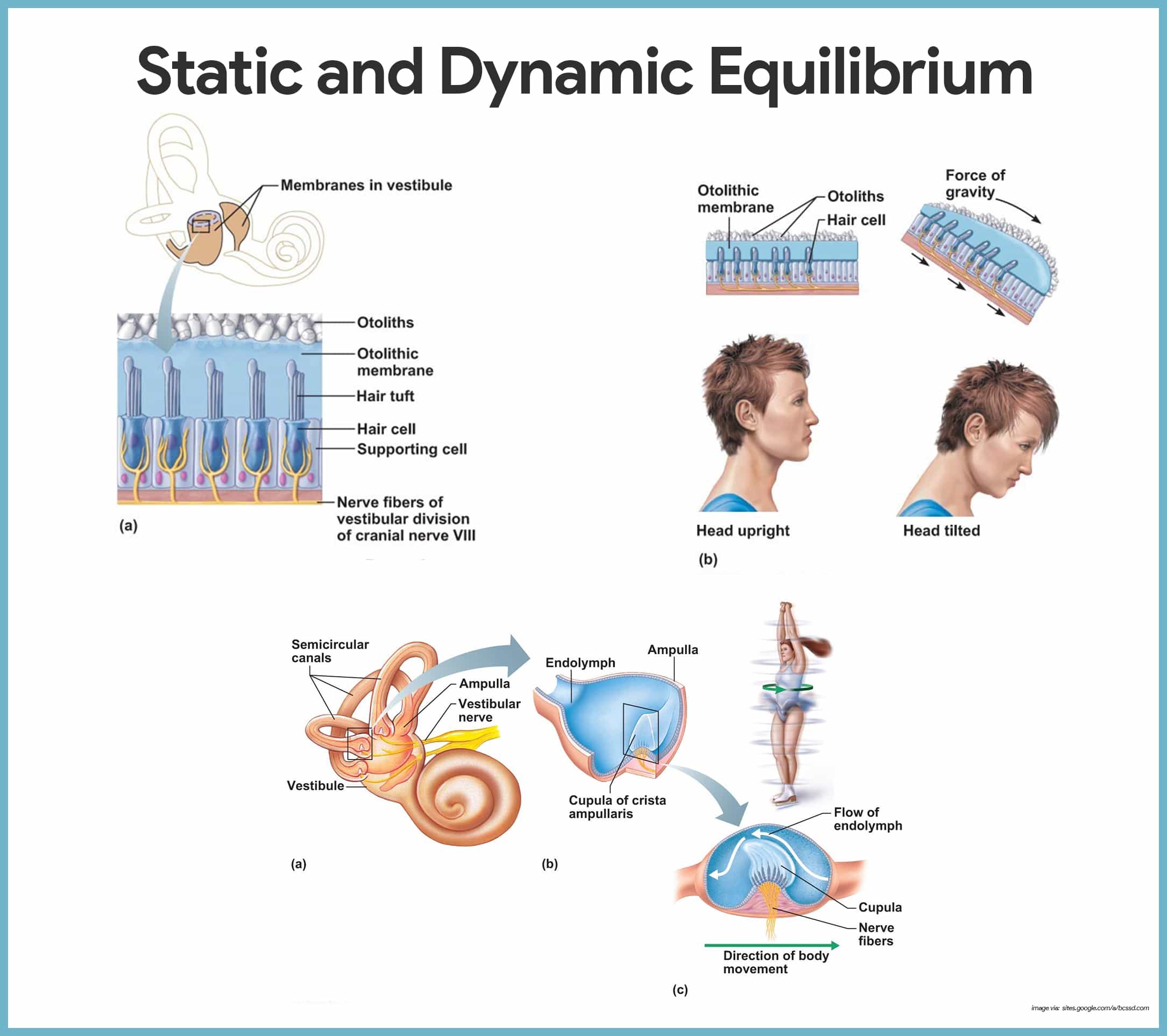
Static Equilibrium
Within the membrane sacs of the vestibule are receptors called maculae that are essential to our sense of static equilibrium.
- Maculae. The maculae report on changes in the position of the head in space with respect to the pull of gravity when the body is non moving.
- Otolithic hair membrane. Each macula is a patch of receptor (hair) cells with their "hairs" embedded in the otolithic hair membrane, a jelly-like mass studded with otoliths, tiny stones made of calcium salts.
- Otoliths. Every bit the head moves, the otoliths roll in response to changes in the pull of gravity; this motion creates a pull on the gel, which in turn slides like a greased plate over the hair cells, bending their hairs.
- Vestibular nervus. This event activates the hair cells, which transport impulses along the vestibular nervus (a sectionalisation of cranial nervus Viii) to the cerebellum of the brain, informing it of the position of the caput in space.
Dynamic Equilibrium
The dynamic equilibrium receptors, constitute in the semicircular canals, reply to angular or rotatory movements of the head rather than to directly-line movements.
- Semicircular canals. The semicircular canals are oriented in the three planes of infinite; thus regardless of which plane one moves in, there will exist receptors to detect the movement.
- Crista ampullaris. Inside the ampulla, a bloated region at the base of each membranous semicircular canal is a receptor region called crista ampullaris, or simply crista, which consists of a tuft of hair cells covered with a gelled cap called the cupula.
- Head movements. When the caput moves in an arclike or athwart direction, the endolymph in the canal lags behind.
- Bending of the cupula. Then, as the cupula drags against the stationary endolymph, the cupula bends- like a swinging door- with the body'southward motion.
- Vestibular nerve. This stimulates the pilus cells, and impulses are transmitted upward the vestibular nerve to the cerebellum.
Machinery of Hearing
The following is the route of sound waves through the ear and activation of the cochlear pilus cells.
- Vibrations. To excite the hair cells in the organ of Corti in the inner ear, sound wave vibrations must pass through air, membranes, bone and fluid.
- Sound transmission. The cochlea is fatigued as though it were uncoiled to make the events of sound transmission occurring in that location easier to follow.
- Low frequency audio waves. Sound waves of low frequency that are beneath the level of hearing travel entirely around the cochlear duct without exciting hair cells.
- Loftier frequency sound waves. Simply sounds of higher frequency result in pressure waves that penetrate through the cochlear duct and basilar membrane to reach the scala tympani; this causes the basilar membrane to vibrate maximally in certain areas in response to certain frequencies of audio, stimulating item hair cells and sensory neurons.
- Length of fibers. The length of the fibers spanning the basilar membrane tune specific regions to vibrate at specific frequencies; the college notes- 20, 000 Hertz (Hz)- are detected by shorter hair cells along the base of the basilar membrane.
Do Quiz: Special Senses Anatomy and Physiology
Hither's a 10-item quiz about the written report guide. Please visit our nursing examination banking concern folio for more NCLEX practice questions.
i. These are sensory nervus endings or specialize cells capable of responding to stimuli past developing action potentials.
A. Mechanoreceptors
B. Chemoreceptors
C. Photoreceptors
D. Thermoreceptors
E. Receptors
F. Nociceptors
1. Answer: East. Receptors
- Choice E: Receptors are sensory nerve endings or specialize cells capable of responding to stimuli past developing action potentials.
- Choice A: Mechanoreceptors respond to mechanical stimuli such as the bending or stretching of receptors.
- Option B: Chemoreceptors reply to chemicals such every bit odor molecules.
- Option C: Photoreceptors: respond to lite.
- Selection D: Thermoreceptors respond to temperature changes.
- Option F: Nociceptors respond to stimuli that result in the sensation of pain.
two. These deeper tactile receptors play an of import function in detecting continuous pressure level in the skin.
A. Merkel's disks
B. Meissner's corpuscles
C. Ruffini's end organs
D. Pacinian corpuscles
2. Reply: C. Ruffini's end organs
- Option C:Ruffini's end organs are deeper tactile receptors that play an important role in detecting continuous force per unit area in the skin.
- Option A: Merkel's disks are pocket-size, superficial nerve endings involved in detecting light affect and superficial pressure.
- Option B:Meissner's corpuscles are receptors for fine, discriminative touch located just deep to the epidermis.
- Option D: Pacinian corpuscles are the deepest receptors associated with tendons and joints. These receptors relay information concerning deep force per unit area, vibration, and position.
three. Which of the following best describes the neuronal pathway for olfaction?
A. Olfactory tracts — Olfactory cortex — Interneurons — Olfactory bulb— Axons from olfactory neurons — Foramina of the cribriform plate
B. Olfactory bulb — Axons from olfactory neurons — Foramina of the cribriform plate — Interneurons — Olfactory tracts — Olfactory cortex
C. Foramina of the cribriform plate — Axons from olfactory neurons — Olfactory bulb — Interneurons — Olfactory tracts — Olfactory cortex
D. Axons from olfactory neurons — Foramina of the cribriform plate — Olfactory bulb — Interneurons — Olfactory tracts — Olfactory cortex
3. Answer: D. Axons from olfactory neurons — Foramina of the cribriform plate — Olfactory bulb — Interneurons — Olfactory tracts — Olfactory cortex
- Option D: Axons from olfactory neurons form the olfactory fretfulness (cranial nerve I), which laissez passer through foramina of the cribriform plate and enter the olfactory bulb . There they synapse with interneurons that relay action potentials to the encephalon through the olfactory tracts . Each olfactory tract terminates in an area of the brain called the olfactory cortex , located within the temporal and frontal lobes.
4. The sensory structures that detect taste stimuli are the:
A. taste buds
B. papillae
C. taste cells
D. gustatory modality hairs
E. taste pore
four. Answer: A. taste buds
- Option A: The sensory structures that notice taste stimuli are the taste buds .
- Option B: Sense of taste buds are oval structures located on the surface of certain papillae , which are enlargements on the surface of the tongue.
- Selection C: Specialized epithelial cells form the outside supporting sheathing of the taste bud, and the interior of each bud consists of nigh 40 taste cells .
- Option D: Each gustation cell contains hairlike processes, called gustation hairs.
- Option East: Taste hairs extend into a tiny opening in the surrounding stratified epithelium, called gustatory modality pore .
5. The accessory structures protect, lubricate, and movement the eye. They include all of the following EXCEPT:
A. eyebrows
B. eyelids
C. conjunctiva
D. lacrimal apparatus
E. extrinsic eye muscles
F. sclera
5. Answer: F. sclera
- Selection F: The sclera is the house, white, outer connective tissue layer of the posterior five-sixths of the fibrous tunic. Information technology helps maintain the shape of the center and provides attachment sites for the extrinsic center muscles.
- Options A, B, C, D, and E: The eyebrows , eyelids , conjunctiva , lacrimal apparatus , and extrinsic centre muscles are considered accessory structures that protect, lubricate, and movement the eye.
6. It is the transparent, inductive sixth of the eye that permits light to enter the middle.
A. Sclera
B. Cornea
C. Lens
D. Iris
E. Pupil
6. Reply: B. Cornea
- Option B: The cornea is the transparent, anterior sixth of the eye that permits light to enter the eye.
- Option A: The sclera is the firm, white, outer connective tissue layer of the posterior five-sixths of the fibrous tunic. Information technology helps maintain the shape of the center and provides attachment sites for the extrinsic eye muscles.
- Option C: The lens is a flexible, biconvex, transparent disc.
- Option D: The iris is the colored part of the eye.
- Option E: The pupil is the opening in the center of the heart.
vii. Information technology is the innermost tunic and information technology covers the posterior v-sixths of the heart.
A. Choroid
B. Ciliary body
C. Suspensory ligaments
D. Retina
vii. Answer: D. Retina
- Pick D: Theretina or nervous tunic is the innermost tunic and it covers the posterior 5-sixths of the middle. Information technology consists of an outer pigmented retina and an inner sensory retina.
- Option A: The choroid is the posterior portion of the vascular tunic, associated with the sclera.
- Option B: The ciliary torso is continuous with the anterior margin of the choroid. It contains smooth muscles chosen ciliary muscles.
- Selection C: Ciliary muscles attach to the perimeter of the lens by the suspensory ligaments .
viii. The sensory retina contains photoreceptor cells called rods which:
A. are very sensitive to lite and can function in very dim lite, but they practice not provide color vision.
B. require much more light, and they do provide colour vision.
C. contain a photosensitive pigment called rhodopsin, which is made up of the colorless protein opsin in loose chemical combination with a yellow paint called retinal.
D. has three types
E. A and C
F. B and D
eight. Reply: E. A and C
- Options A and C: The sensory retina contains photoreceptor cells called rods and cones, which respond to lite. Rods are very sensitive to calorie-free and can role in very dim light, but they do non provide color vision. Rod cells comprise a photosensitive pigment called rhodopsin, which is made upward of the colorless protein opsin in loose chemical combination with a yellow pigment called retinal.
- Options B and D: Cones require much more lite, and they practice provide color vision. There are 3 types of cones, each sensitive to a different color: bluish, green, or red. The many colors that we can see outcome from stimulation of combinations of these iii types of cones.
ix. The heart ear contains 3 auditory ossicles which are the:
A. external acoustic meatus, ceruminous glands, and eardrum.
B. malleus, incus, and stapes.
C. bony labyrinth, bleary labyrinth, and cochlea.
D. oval window, round window, and anteroom.
ix. Answer: B. malleus, incus, and stapes.
- Option B: The centre ear contains three auditory ossicles which are themalleus, incus, and stapes.
- Choice A: The external acoustic meatus , ceruminous glands , and the tympanic membrane or eardrum are parts of the external ear .
- Options C and D: The bony labyrinth , membranous labyrinth , cochlea , oval window , round window , and vestibule are parts of the inner ear .
10. Information technology is a component that is associated with the vestibule and is involved in evaluating the position of the head relative to gravity.
A. Balance
B. Static
C. Kinetic
D. Equilibrium
10. Respond: B. Static
- Option B: Static equilibrium is a component of equilibrium that is associated with the vestibule and is involved in evaluating the position of the caput relative to gravity.
- Option C:Kinetic equilibrium is another component of equilibrium that is associated with the semicircular canals and is involved in evaluating changes in the direction and rate of head movements.
Source: https://nurseslabs.com/special-senses-anatomy-physiology/
0 Response to "Special Senses Anatomy of the Visual System Review Sheet"
Post a Comment